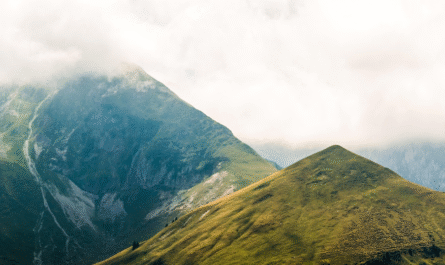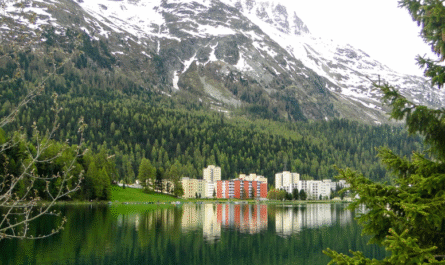Saint Moritz and the surrounding Engadin Valley are a study in seasonal duality: in winter the mountains glitter with polo ponies cantering across a frozen lake and skiers carving beneath moon‑lit ridges, while in summer the same peaks bloom into a playground for kitesurfers harnessing the Maloja wind and hikers tracing flower‑rimmed ridgelines. Experiencing these summits in both extremes reveals how climate, culture, and sport transform across the calendar without ever betraying the valley’s trademark blend of high‑altitude glamour and raw Alpine beauty. The guide that follows—well over 1,500 words—shows winter and summer head‑to‑toe: snow versus scree, thermal layers versus trail shoes, fondue huts versus lakeside picnics. Use it to decide when, how, and why to meet Saint Moritz’s peaks on their own terms.
WINTER: PEAKS IN A CRYSTAL KINGDOM
1. Snow‑Carved Icons
Three ski areas dominate Saint Moritz’s winter skyline:
- Corviglia rides above town with long corduroy boulevards perfect for intermediate skiers who love speed.
- Corvatsch boasts Switzerland’s highest full‑moon ski night. Every Friday its 4.2‑kilometre flood‑lit slope glows until after midnight, followed by fondue at the mid‑station restaurant.
- Diavolezza delivers steep glacier terrain and rare Glüna Plaina events, when the lifts open only on full‑moon evenings so skiers can descend silver slopes under lunar light.
Together they offer about 350 kilometres of pistes plus lift‑assisted off‑piste itineraries that tempt Olympians and first‑timers alike.
2. Signature Events on Ice
- Snow Polo World Cup (late January) – The frozen Lake Saint Moritz transforms into the world’s only high‑goal polo tournament played on compacted snow. VIP tents ripple with fur coats and champagne flutes; meanwhile, thundering hooves kick up ice crystals beneath the Engadin sun.
- The Cresta Run (January–February) – A 1.2‑kilometre natural ice chute where riders hurl themselves head‑first on skeleton sleds at speeds topping 140 km/h. The track has operated since 1885 and remains one of the valley’s purest adrenaline rites.
- Engadin Ski Marathon (second Sunday in March) – Fourteen thousand Nordic skiers flood the valley to glide 42 kilometres from Maloja to S‑chanf across frozen lakes and past larch forests. Even amateurs can register if they meet modest time qualifications.
3. Off‑Slope Winter Rituals
- Muottas Muragl Toboggan Run – A 4.2‑kilometre sled track full of hairpin turns and one of the grandest sunset vistas in the Alps.
- Horse‑Drawn Sleighs in Val Roseg – Swap skis for wool blankets and glide beneath ice‑laden pines to a glacier‑circle café serving hot chocolate topped with mountain cream.
- Thermal Reward at Ovaverva – Float in a rooftop pool facing Piz Rosatsch after a day above the treeline; steam clouds curl into sub‑zero air while stars scatter overhead.
4. Gear & Practicalities
Temperatures can drop to –15 °C. Pack a wicking base layer, mid‑weight merino, and a wind‑proof shell. Goggles with low‑light lenses cut glare from floodlights or full moons during night skiing. Hydrate aggressively—dry mountain air dehydrates faster than beach heat—and apply high‑factor sunscreen: UV intensity rises about ten percent per thousand metres of elevation. The regional lift pass integrates local buses and trains, letting you ski three resorts in one day without touching a steering wheel.
SUMMER: PEAKS IN AN ALPINE GARDEN
1. Trails in Bloom
When snow recedes, Corviglia flips into a mosaic of hiking and biking paths. A multi‑day Hiking Pass unlocks all Engadin lifts, whisking walkers to the Panorama Trail that arcs from Piz Nair past marmot burrows and lakes the colour of malachite. Mountain‑bike aficionados chase both bermed flow‑lines built for speed and natural single‑track dropping to Celerina. The network draws professional racers for altitude training yet still offers mellow lakeside loops for families pushing strollers.
2. Winds and Water
Afternoons bring the reliable Maloja wind funneling down the valley, transforming Lake Silvaplana into Europe’s highest kitesurfing arena. Beginners take foil‑board lessons near the shore while seasoned riders carve turquoise crescents across the lake. Stand‑up paddleboard yoga sessions greet dawn on nearby Lake Saint Moritz; sailors tack lazily across Lake Sils under cotton‑wool clouds reflected on glassy surfaces.
3. Cultural High Season
- Festival da Jazz (July) – Historic hotel ballrooms and alpine huts become intimate stages where Grammy winners and Swiss up‑and‑comers jam only metres from the audience.
- Engadin Festival (August) – Two weeks of chamber and orchestral concerts echo through 17th‑century churches and open‑air chapels, blending Vivaldi with cowbells in the distance.
- Full‑Moon Apéros on Diavolezza – A late‑night cable‑car ride leads to alpine tapas, telescopes pointed at Jupiter, and a Milky‑Way sky free of city light.
4. Quiet Thrills
- Bernina Express Panorama Walks – Ride the UNESCO‑listed red train over spiral viaducts, then hike back parallel to the tracks, trading steel for silence and goat bells.
- Val Fex Car‑Free Trek – Luggage travels by horse cart while hikers stroll between dairy huts producing tangy alp cheese. No engines, just rivers and hoofbeats.
- Wild‑Swimming at Lake Staz – Dawn dips amid misty reeds, followed by coffee at a stilted boathouse café whose deck juts over emerald water.
5. Summer Essentials
Daytime peaks can reach 22 °C, yet UV remains fierce. Pack breathable layers, a rain shell for sudden storms, and trekking poles for scree descents. Many hotels offer a Mountain Railways Included program—free lift access after two nights—perfect for altitude acclimatisation without premium ticket costs.
THE SHOULDER SEASONS
Late April and early November deliver hotel bargains but limited lift operations. Spring reveals frozen‑lake breakup into geometric plates that clink like glass chimes along the shore. Autumn ignites larch forests in gold and copper, and the Maloja wind calms enough for glassy‑lake reflections prized by photographers. Ski mountaineers may skin the Diavolezza glacier in April for corn snow, while cyclists race along nearly empty valley roads used by professional teams for high‑altitude training.
WINTER vs SUMMER AT A GLANCE
| Factor | Winter (Dec–Mar) | Summer (Jun–Aug) |
|---|---|---|
| Flagship Sport | Alpine skiing, snow polo, Cresta Run | Hiking, mountain biking, kitesurfing |
| Iconic Event | Engadin Ski Marathon | Festival da Jazz |
| Unique Experience | Full‑moon glacier descent | Maloja‑wind kitesurf session |
| Average Temp Valley | –8 °C | 18 °C |
| Wildlife Sighting | Snow hares, ibex on sunny slopes | Marmots, golden eagles riding thermals |
| Cuisine Focus | Fondue huts, mulled wine | Lakeside picnics, alpine cheese boards |
SUSTAINABILITY NOTES
Saint Moritz promotes rail travel to cut road congestion; the Bernina and Albula lines run on hydropower. Winter visitors should ski within marked areas to protect sub‑nivean wildlife shelters, and summer hikers must pack out all trash from high pastures where alpine ibex graze.
BUDGET & LOGISTICS HACKS
- Timing Deals – Book early December or mid‑January for quieter slopes before high‑society polo crowds. Choose mid‑June before European schools break for summer.
- Pass Combos – The Hotel Ski Pass offers discounted lift tickets for winter guests staying two nights or more. The Engadin Hiking Pass covers three to seven consecutive days of summer lifts.
- Luggage Transfer – Swiss Rail ships skis or bicycles door‑to‑door, freeing you to board scenic trains unencumbered.
- Altitude Adjustment – Spend your first night below 1,700 metres—Celerina or Samedan—if you’re arriving from sea level to ease the jump before tackling 3,000‑metre summits.
EXPERIENCES IN 48 HOURS
Winter Blitz
Day 1: Dawn run down Corviglia’s freshly groomed “White Carpet”; lunch on chia‑seed Pizokel pasta at Alp Giop; afternoon sleigh ride into Val Roseg; sunset drinks on the Palace Hotel terrace; night‑ski Corvatsch under flood‑lights until midnight.
Day 2: Watch daredevils at the Cresta Run; ski morning laps on Diavolezza’s glacier; warm up with raclette in a candle‑lit mountain hut; end day ringside at the Snow Polo World Cup.
Summer Sampler
Day 1: Sunrise paddleboard yoga on Lake Staz; cable car to Piz Nair, hike the Panorama Trail; picnic at Lej Alv with local cheese and rhubarb soda; afternoon kitesurf lesson on Lake Silvaplana; evening jazz set at the Dracula Club.
Day 2: Morning flow‑trail mountain‑bike run from Corviglia to Celerina; guided alpine‑herb foraging in Val Fex; gondola to Muottas Muragl for a five‑course sunset dinner under alpenglow.
FINAL THOUGHTS
Saint Moritz’s peaks invite two very different love affairs depending on whether you arrive swaddled in down or dressed in quick‑drying merino. Winter offers a crystal kingdom of moon‑washed glaciers, thundering sled runs, and champagne‑soaked polo matches on ice. Summer counters with electric wind surf across turquoise lakes, single‑track stoke under pine scent, and jazz chords drifting through larch canopies. Sample both seasons, and you’ll discover the mountains are not switching personalities so much as revealing complementary facets of one enduring soul—an alpine muse equal parts adrenaline and artistry. Choose your season, pack wisely, and let the Engadin show you how the same summit can tell two unforgettable stories.
Experiencing Saint Moritz in opposite seasons also reframes your understanding of time. Winter condenses the hours—daylight is fleeting, schedules revolve around first‑chair lifts or the exact moment the lake ice is safe for polo. Summer stretches the clock: sunrise arrives before 6 a.m., twilight lingers until nearly ten, and the valley invites a languid pace that encourages spontaneous detours—another swim, another alpine herb to identify, another jazz encore in an open courtyard. Living both tempos teaches you to calibrate energy to nature’s metronome rather than to a digital calendar.
The seasonal contrast further underscores the versatility of local culture. The same Engadin craftspeople who forge carbon‑fiber Cresta sleds in December pivot to hand‑carving elaborate Sgraffito house motifs come July. Chefs shift from molten fondue and venison ragout to chilled barley soups and foraged chanterelle salads. Witnessing that fluidity makes you question rigid definitions of tradition; in Saint Moritz, authenticity isn’t frozen in time but evolves with each temperature shift, proving that heritage can be dynamic without losing its roots.
For travelers chasing lower‑impact adventures, alternating seasons also spreads visitor load, reducing pressure on fragile ecosystems. Summer tourists who return in winter—or vice versa—gain a firsthand appreciation of conservation challenges: they see how ski pistes metamorphose into marmot meadows and understand why staying on marked trails, regardless of season, protects both powder quality and alpine flora. Such cyclical awareness fosters stewardship more effectively than any signpost ever could.
The dual‑season perspective likewise reshapes personal fitness goals. A skier who spends July mountain‑biking the same gradients discovers newfound leg strength when carving January moguls. Conversely, a summer trail runner who later tackles skin‑track ascents gains respect for snow science and avalanche safety. Saint Moritz becomes an outdoor classroom where lessons learned under one set of weather conditions elevate performance and safety under another—an ongoing curriculum tailored by the mountains themselves.
Finally, switching between Saint Moritz’s winter sparkle and summer bloom invites a philosophical takeaway: identity, like a mountain, can hold conflicting truths without fracture. You can be the same person who relishes midnight fondue after a moonlit descent and who later savors dawn yoga on a glassy lake. The peaks stand as proof that dualities are not contradictions but complementary facets of a richer whole—a reminder to embrace the full spectrum of experiences, climates, and moods that shape an adventurous life.



